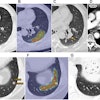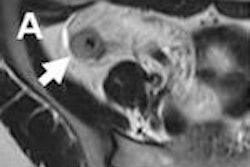Coping with pediatric radiation exposure
Some clinicians believe that fears about CTE-related radiation will diminish as improved dose reduction techniques are introduced. Two recent studies in particular exemplify how CTE radiation can be reduced without losing image quality.
Dr. Avinash Kambadakone at MGH used iterative reconstruction to cut dose from CTE by about one-third compared with a traditional filtered back-projection reconstruction technique (AJR, June 2011, Vol. 196:6, pp. W743-W752). And at the Cleveland Clinic in Ohio, Dr. Brian C. Allen and colleagues drew from the findings of a prospective trial to recommend optimal settings for an automatic exposure control during CTE performed with 16- and 64-slice scanners (AJR, July 2010; Vol. 195:1, pp. 89-100).
Generally, radiologists have decreased exposure in CTE exams by restricting imaging acquisition to either the vascular or arterial phase, depending on the application.
Dealing with MRE's high costs
The relatively high cost of MRE can be a problem for clinicians who order it for their young patients. The University of Michigan Medical Center charges $7,000 for an MRE exam compared with $1,500 for CTE, according to Higgins. The higher charge has a few insurers insisting on bizarre ways to reduce their costs, he noted. One payor approved payment for the pelvic portion of an MRE exam, but denied it for the abdominal portion.
At MGH, Gee has seen no evidence of payor resistance to MRE, though his department seeks reimbursement for MRE to only cover specific indications for pediatric patients or evaluations of small-bowel fistulas or abscesses.
In response to an email inquiry, an Aetna spokesperson wrote that it has no clinical policy preventing the use of MRE in younger patients with Crohn's disease. But he admitted that prior authorization policies applied by individual Aetna plans could be an impediment.
In response to email inquiries, Cigna replied that it covers MRE for children and adults when deemed medically necessary, recognizing the need for MRE for young patients to avoid radiation exposure.
Cigna's payment experience indicates that MRE is twice as expense as CTE, however. Its average cost for CTE is about $950, compared with about $1,800 for MRE.
In Europe, higher MRE costs have not discouraged clinicians from ordering it, according to Dr. Julian Panes, chief of gastroenterology at the Hospital Clinic of Barcelona in Spain. The costs at Panes' hospital and the Academic Medical Center in Amsterdam, the Netherlands, are comparable. Both charge from $400 to $467 for MRE and $266 to $300 for CTE.
Other applications
In addition to Crohn's disease, CTE and MRE are being used to detect small-bowel tumors. Such malignancies are rare, and their symptoms are nonspecific. Clinicians typically test for more likely causes before considering the possibility of small-bowel cancer. At a result, diagnosis is often delayed, thereby increasing the need for a highly sensitive test when it is finally performed, Elsayes said. CTE meets that need with a 90% detection rate for carcinoid and other tumors.
CTE is also showing early promise for tracking down the sources of obscure GI bleeding that evades detection with conventional and capsule endoscopy. These techniques have been typically less than 50% sensitive for localizing the cause of bleeding.
In a recently published trial, Dr. James Huprich, an associate professor of radiology at the Mayo Clinic, and colleagues determined that multiphasic CTE was more than twice as sensitive as capsule endoscopy for finding the source of obscure GI bleeding. The sensitivity of CTE for 16 patients was 88%, compared with 38% for capsule endoscopy (Radiology, September 2011, Vol. 260:3, pp. 744-751).
Future development
MGH radiologists have begun performing 3-tesla MRE, though it has been a challenge, Gee said. Imaging with 3-tesla systems offers an improved signal-to-noise ratio that can be used to either cut exam times or boost image resolution, but the risk of susceptibility artifact is much greater than during 1.5-tesla imaging. Air must be carefully eliminated from the bowel to avoid susceptibility artifacts from affecting the evaluation of the mucosa, he said.
Dr. Seung Soo Lee and colleagues from the University of Ulsan College of Medicine in Seoul, South Korea, reported encouraging results with a triphasic CTE protocol involving 1,800 mL of a neutral enteric agent for bowel distention. The scheme achieved 71% sensitivity this year with CTE in seven patients with positive at capsule endoscopy (Radiology, June 2011, Vol. 259:3, pp. 739-748).
Researchers are also investigating a possible role for diffusion-weighted MR. It may emerge as another way to identify active inflammatory Crohn's disease by mapping the pattern of edema that restricts water diffusion in the bowel wall, Gee said.
Bruining envisions a promising future for CT enterography. The modality has all the ingredients for broad community-based adoption, he said. Multislice CT is widely available and inexpensive compared with MRI. Low-dose techniques will likely calm fears about radiation exposure, while improved CTE applications, especially the ability to distinguish inflammatory processes from fibrotic disease, will win over gastrointestinal radiologists and gastroenterologist to the merits of the technology.
"These are the kinds of things that are being looked at to see if we can predict the inflammatory component for people with strictures and how well they are likely to respond to therapy," Bruining said.
Previous page | 1 | 2 | 3




















